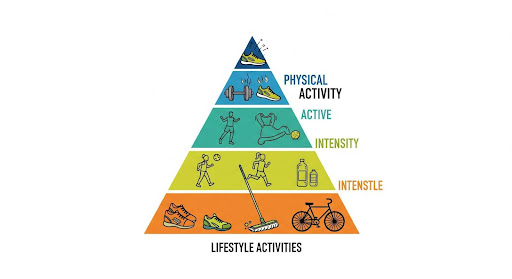Have you ever caught yourself walking to the fridge and thinking, “Well, that’s exercise, right?” Maybe it’s the act of parking a little farther from the store entrance or even that brisk 10-minute walk around your block after dinner. In my line of work, where science meets wellness, I often get asked, “Where on the physical activity pyramid do lifestyle activities belong?” Well, let me break it down for you, because it’s a question with a bit of nuance—and yes, those little movements truly count.
So, let’s get into it!
What Is the Physical Activity Pyramid, and Why Should You Care?

First, let’s clear up what we’re dealing with. The physical activity pyramid is like a roadmap for staying active throughout your day. Imagine it as a visual guide for everything from basic movements to intense workouts.
At the bottom, we have the most fundamental activities—the ones you should do every day—while at the top, there are more specialized exercises.
Now, lifestyle activities are often overlooked, but they’re right at the foundation of this pyramid for a good reason. They’re your go-to, low-intensity movements—think walking, light gardening, even standing while chatting on the phone.
These are the kinds of activities that many people do instinctively without even thinking about it, and they’re integral to your overall health.
Why Lifestyle Activities Matter More Than You Think
Here’s the secret: the physical activity pyramid isn’t just for gym-goers or marathon runners. Lifestyle activities sit at the bottom because they form the foundation of a healthier life.
They’re simple, often daily actions that may seem insignificant but can dramatically improve your health over time. For instance, walking to work, taking the stairs, or stretching while watching TV doesn’t require special gear or a gym membership.
And guess what? These small shifts in daily behavior help improve your cardiovascular health, reduce stress, and even support weight management.
Think about it: we all have 24 hours in a day, and how we spend them determines a lot. If you’re consistently moving throughout your day—even if it’s just light movement—you’re setting yourself up for a more active and longer life.
How Much Physical Activity Should You Aim for in a Day?

When I talk to people about their goals, many ask how much movement is enough. I always say: it depends on your baseline. According to experts, it is recommended to aim for at least 150 minutes of moderate physical activity per week. That’s just a little over 20 minutes a day—yes, even spread across short bursts of walking, stretching, or getting up every hour.
Lifestyle activities are the golden ticket to hitting this goal without thinking you need to train for a marathon. These movements, added up, can help you meet that baseline without any hardcore gym sessions. And if you’re aiming for weight loss or general fitness, they build a solid foundation for adding more structured exercise later on.
How to Make the Most of Lifestyle Activities
It’s easy to get caught in the trap of thinking “I don’t have time for exercise.” But with a little creativity, you can incorporate more movement into your day without major life changes.
Here’s how you can maximize your lifestyle activity:
- Turn Chores Into Workouts: Doing laundry? That’s squats every time you bend down. Vacuuming? Try power walking around the house. Mopping the floors? That’s a great chance to stretch and move those muscles.
- Walk, Don’t Drive: If you’re close to your destination—walk. If it’s a short trip, walk to the store, your friend’s house, or just around the block. This is one of the easiest ways to get in more daily steps.
- Take Breaks: When you’re working from home or the office, get up every hour and walk around, stretch, or do a few quick lunges. Your body will thank you for the extra blood flow.
- Active Family Time: Walk the dog, take a family bike ride, or play a game of tag with your kids. Make it fun, and you won’t even realize you’re moving.
Frequently Asked Questions
-
Can lifestyle activities really improve my health?
Yes! Small, consistent actions like walking or stretching can have long-term positive effects on your health, improving everything from heart health to mental clarity.
-
How much time should I spend on lifestyle activities each day?
It’s all about finding your balance. Ideally, aim for about 30 minutes of light activity spread throughout the day. That’s easy to fit in—whether it’s walking, cleaning, or even standing more often.
-
Can lifestyle activities replace structured workouts?
While lifestyle activities are essential, they should complement—not replace—structured workouts. A healthy mix of both will provide the best overall health benefits.
-
How do I know if I’m getting enough physical activity through lifestyle movements?
If you’re moving every day, you’re likely getting enough. Look for ways to make those “little movements” more intentional, like parking further away or setting a timer to remind you to stretch.
 Credit: Gemini
Credit: Gemini
Let’s Wrap It Up: The Secret to Lasting Wellness
It’s easy to underestimate lifestyle activities, but here’s the truth: they’re the secret sauce to staying healthy without feeling like you’re constantly working out.
The physical activity pyramid is there for a reason, and lifestyle activities sit proudly at the bottom as the most accessible way to stay active throughout your life.
The next time you take the stairs, go for a walk, or stretch your back after sitting for hours, think of it as part of your long-term wellness plan. Small actions? Big benefits.
 Credit: Gemini
Credit: Gemini
Pro Tip: Don’t get caught up in the all-or-nothing mindset. Your lifestyle activity pyramid is all about being consistent, not perfect. So, next time you’re wondering if that extra step counts, just remember: it all adds up.












